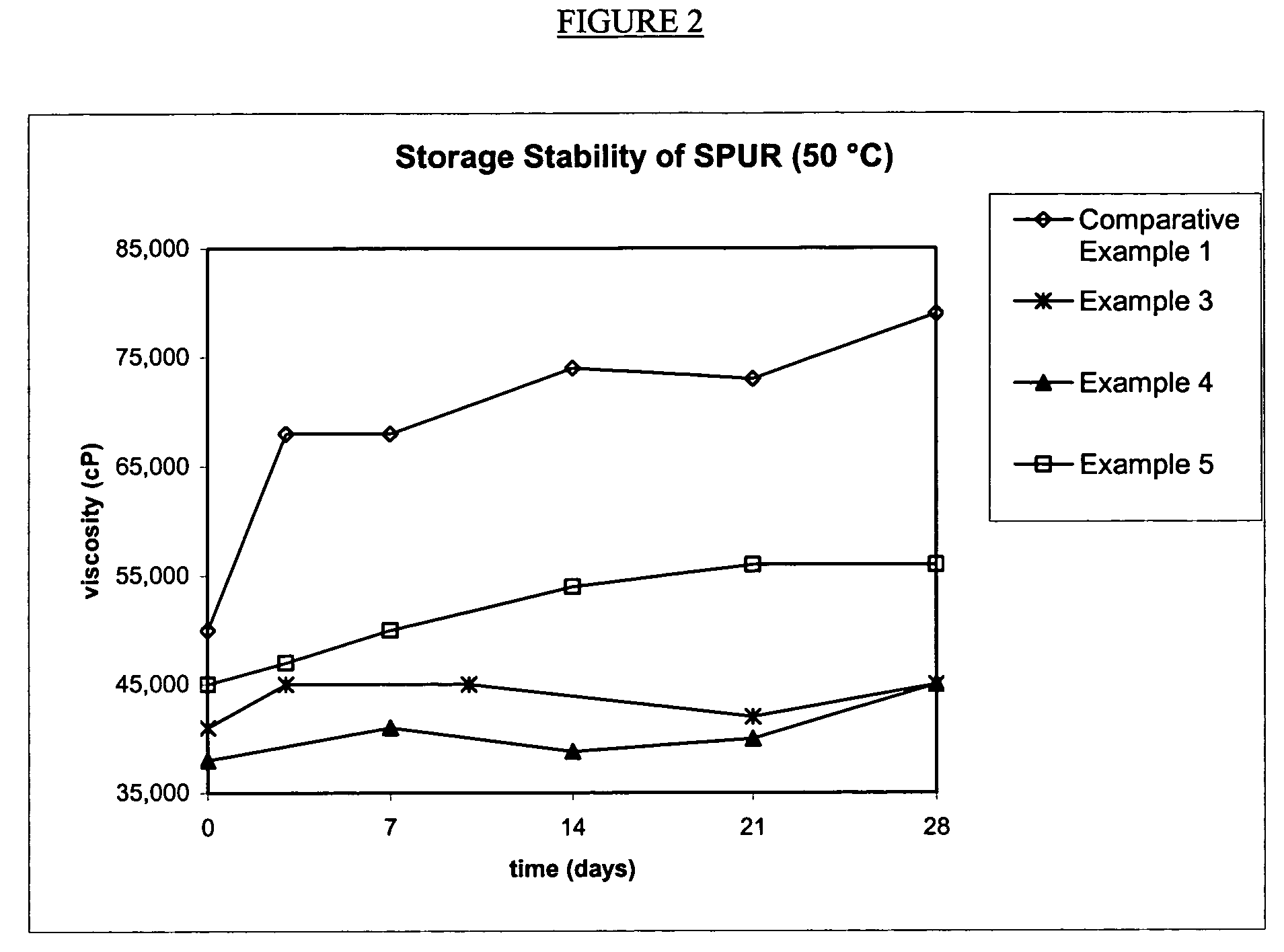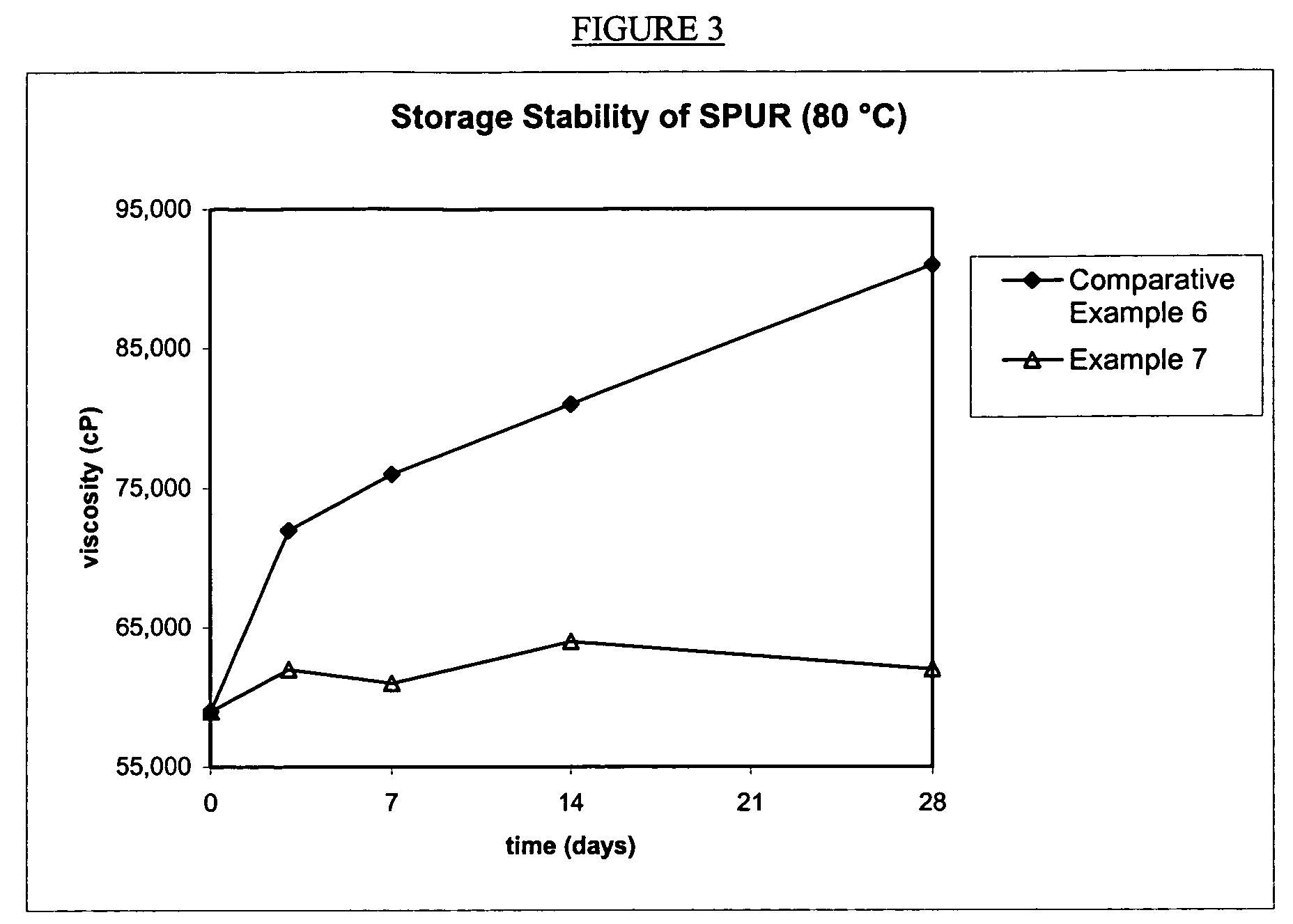Process for preparing a curable silylated polyurethane resin
a polyurethane resin and silylated technology, applied in the field of curable silylated polyurethane resin preparation, can solve the problems of difficult to ensure that all of the isocyanate has reacted with the hydroxyl-terminated polymer, unsatisfactory increase in product viscosity, etc., and achieve the effect of reducing isocyanate content and improving viscosity stability
- Summary
- Abstract
- Description
- Claims
- Application Information
AI Technical Summary
Benefits of technology
Problems solved by technology
Method used
Image
Examples
example 3
[0055]The silylated polyurethane resin with isocyanate-reactive scavenging agent was made by a batch process. Into a 22 L reactor were charged Acclaim® 12200N polyol (Bayer, OH #10.2 mgKOH / g, 14600 g) and Irganox® 1135 (Ciba, 73 g). The mixture was sparged with nitrogen at 85° C. for 16 hours. While maintaining the reaction temperature at 85° C., sequentially were added 85% phosphoric acid (35 μL), isophorone diisocyanate (Bayer, Desmodur® I, 147.5 g) and dibutyltin dilaurate (General Electric Advanced Materials, Fomrez® Catalyst SUL-4, 7.77 g of a 10 wt % solution in di(propylene)glycol dimethyl ether). The mixture was reacted until the viscosity was 22,000 cP and the isocyanate concentration was 0.10%, at which point was added 3-isocyanatopropyltrimethoxysilane (General Electric Advanced Materials, Silquest® A-Link™ 35, 302.3 g). The reaction was continued until the reaction mixture reached viscosity 52,000 cP and isocyanate concentration 0.07%, when methanol (9.21 g, 0.06 wt %, s...
example 4
[0056]The silylated polyurethane resin with isocyanate-reactive scavenging agent was made by a batch process. Into a 22 L reactor were charged Acclaim® 12200N polyol (Bayer, OH #10.2 mgKOH / g, 14600 g) and Irganox® 1135 (Ciba, 73 g). The mixture was sparged with nitrogen at 85° C. for 16 hours. While maintaining the reaction temperature at 85° C., sequentially were added 85% phosphoric acid (35 μL), isophorone diisocyanate (Bayer, Desmodur® I, 147.5 g) and dibutyltin dilaurate (General Electric Advanced Materials, Fomrez® Catalyst SUL-4, 7.77 g of a 10 wt % solution in di(propylene)glycol dimethyl ether). The mixture was reacted until the viscosity was 20,000 cP and the isocyanate concentration was 0.10%, at which point was added 3-isocyanatopropyltrimethoxysilane (General Electric Advanced Materials, Silquest® A-Link™ 35, 302.3 g). The reaction was continued until the reaction mixture reached viscosity 47,000 cP and isocyanate concentration 0.06%, when methanol (18.4 g, 0.12 wt %, s...
example 5
[0057]The silylated polyurethane resin with isocyanate-reactive scavenging agent was made by a batch process. Into a 22 L reactor were charged Acclaim® 12200N polyol (Bayer, OH #10.2 mgKOH / g, 14600 g) and Irganox® 1135 (Ciba, 73 g). The mixture was sparged with nitrogen at 85° C. for 16 hours. While maintaining the reaction temperature at 85° C., sequentially were added 85% phosphoric acid (35 μL), isophorone diisocyanate (Bayer, Desmodur® I, 147.5 g) and dibutyltin dilaurate (General Electric Advanced Materials, Fomrez® Catalyst SUL-4, 7.77 g of a 10 wt % solution in di(propylene)glycol dimethyl ether). The mixture was reacted until the viscosity was 27,000 cP and the isocyanate concentration was 0.07%, at which point was added 3-isocyanatopropyltrimethoxysilane (General Electric Advanced Materials, Silquest® A-Link™ 35, 302.3 g). The reaction was continued until the reaction mixture reached viscosity 57,000 cP and isocyanate concentration 0.05%, when a mixture of methanol (18.4 g,...
PUM
| Property | Measurement | Unit |
|---|---|---|
| weight percent | aaaaa | aaaaa |
| weight percent | aaaaa | aaaaa |
| temperature | aaaaa | aaaaa |
Abstract
Description
Claims
Application Information
 Login to View More
Login to View More - R&D
- Intellectual Property
- Life Sciences
- Materials
- Tech Scout
- Unparalleled Data Quality
- Higher Quality Content
- 60% Fewer Hallucinations
Browse by: Latest US Patents, China's latest patents, Technical Efficacy Thesaurus, Application Domain, Technology Topic, Popular Technical Reports.
© 2025 PatSnap. All rights reserved.Legal|Privacy policy|Modern Slavery Act Transparency Statement|Sitemap|About US| Contact US: help@patsnap.com



